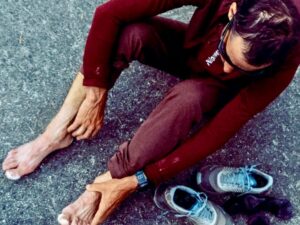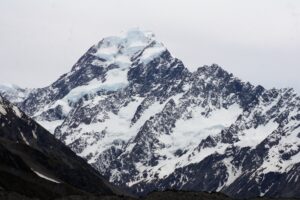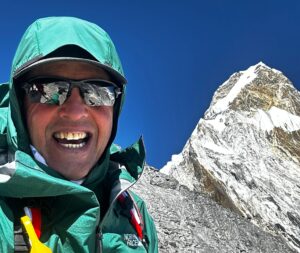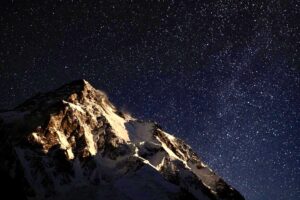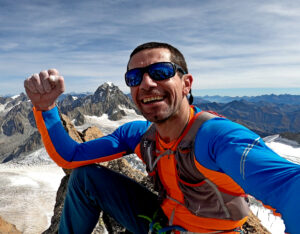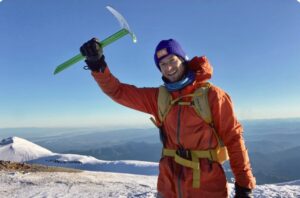Yesterday, Dmitry Grekov of Ak-Sai Travel announced an unusual first on 7,010m Khan Tengri. One of Grekov’s clients, Siegfried Meesters, had reached the summit supported by Nepali guide Dawa Sherpa. The first? Meesters had used supplementary O2.
Rather than concealing the use of bottled oxygen, as some climbers might, Grekov publicized it. He explained to ExplorersWeb how his company intends to enlarge its target market and facilitate faster trips.
Grekov noted that the entire expedition took only five days. The average expedition to Khan Tengri takes at least three weeks.

Summit day on Khan Tengri. Photo: Ak-Sai Travel
Growing opportunities
“After many years working with sport climbers on Lenin peak, Khan Tengri, and Pobeda, we decided to help a wider variety of people come to our base camps,” Ak-Sai Travel staff member Yulia Pimenova explained. The company is based in Bishkek, Kyrgyzstan, and has serviced expeditions in central Asia for over 20 years.
“This program is for those who do not have an interest in sports goals but wish for an amazing experience. It is for guests who have limited time, and for all the people who previously thought that this kind of activity was not for them,” she added. “Now they can try and decide for themselves in which way they want to go further.”
Basically, it is the same argument used on the 8,000’ers. The Kyrgyz outfitter sees an opportunity to attract clients who would not be capable of a no-O2 climb. However, they noted that they would also keep organizing standard no-O2 expeditions.
A rapid ascent
The format for an ascent of Khan Tengri with supplemental O2 is simple and very fast. The clients are guided through the three higher camps. The clients rest in Camp 1 (4,000m) for a couple of days and then proceed to Camp 2, which is 200m higher. On arrival in Camp 3 (5,800m), they use O2 to sleep. The clients will then wear their masks through the following summit day.

Camp 3 on Khan Tengri. Photo: Ak-Sai Travel
Ak-Sai Travel explained that Meesters is European, with previous experience in the Alps. Meesters chose the O2-assisted program because he had limited time.
“After observing his condition, he was allowed to travel from Camp 1 to Camp 2 without oxygen, which Meesters suggested because he felt well in our camp,” Ak-Sai Travel said. “After a short stop in Camp 2, he left for Camp 3 with the support of oxygen, which is mandatory in this fast program, for the client’s safety.
“The way from Camp 3 to the summit took around eight hours and the way back around four hours. They returned to Base Camp before breakfast.”

7,010m Khan Tengri. Photo: Dmitry Grekov
Khan Tengri, located on the border between China, Kazakhstan, and Kyrgyzstan, is the most popular peak in the Tien Shan range (and the second highest, after Pobeda). It is also one of the peaks required to complete the Snow Leopard challenge — summiting the highest peaks in the former Soviet Union. The USSR is long gone, but the project remains attractive for both local and international climbers.
Khan Tengri, the northernmost 7,000’er in the world, is a highly demanding climb, only for experienced and well-prepared climbers. According to SummitPost, it is the third most difficult peak of the Snow Leopard group, after Pobeda and Ismail Somony.
Aconcagua next?
The increasing use of supplementary oxygen at relatively low altitudes is intimately related to the commercialization of high-altitude mountaineering. The business model focuses on safety and summit chances, and there is a large market ready to accept assistance.
As seen this season in Pakistan, the business model has taken over all 14 8,000’ers and other popular peaks in the Himalaya. It was only a question of time before the model spread to other mountain ranges and the Seven Summits.
UK guide Kenton Cool told ExplorersWeb that a number of outfitters are considering supplying bottled O2 for Aconcagua. In fact, some have already started.

Furtenbach Adventures’ clients and guides on Aconcagua. Photo: Pablo Betancourt
Furtenbach Adventures confirmed that they have used supplementary O2 on Aconcagua in the past. As far as they know, they were the first outfitter to use it there.
“We don’t use it for weak clients but more for future Everest clients to test the oxygen system and see how it feels before heading for the Himalaya,” Lukas Furtenbach told ExplorersWeb. Some other outfitters adopted the idea last winter and more are considering it for the 2023 season.

